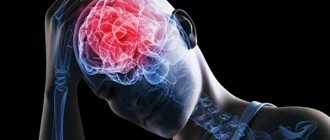Severity of injury
In order for the provision of assistance to the victim to really have the desired effect, experts recommend conducting at least a cursory initial examination before starting pre-medical procedures. This will allow you to determine the approximate severity of the head injury.
The easiest way to cope is with a mild degree of the disease, which is more typical of accidental household injuries such as hitting your head on the edge of a cabinet. The deviation is not accompanied by any heavy bleeding and does not bring any particular discomfort during recovery. Typically, such mild bruises are limited to the formation of a small swelling, which is popularly called a “bump.”
It goes away on its own, but sometimes, to speed up the process, it is allowed to apply cold immediately after the blow. This will somewhat reduce pain and also limit the spread of swelling.
The situation with damage to the integrity of the skin is a little more complicated. The category includes not only extensive wounds that occur when a large area of skin along with hair is combed. Even ordinary abrasions provoke an outflow of blood. But only in the first case the patient has to deal with a large amount of blood, and in the second case only capillary bleeding is stopped.
If emergency measures are taken, it will be possible to block capillary breaks to stop bleeding within 5-10 minutes.
Three other categories are considered separately:
- jaw damage;
- traumatic brain injury;
- combined options.
Complex pathologies are more suitable for describing polytrauma, when, in addition to deformation of the head, destabilization of the spine or any other part of the body is simultaneously recorded. This format is most often found in road accidents, fights and industrial injuries, when there is damage to the chest and limbs.
A particularly serious development of events is a related deviation in the issue of the integrity of the neck systems. We are talking about the rupture of nerve endings and large vessels designed to nourish the brain.
Almost always, a head blow is accompanied by minor, but still skin injuries. In addition to the immediate top layer, the natural integrity of the fatty tissue is disrupted. Because of this, blood flow through the affected vessels is obstructed. The clinical picture ends with the collection of blood at the site of localization, which externally transforms into a hematoma of various sizes.
Depending on the severity and duration of the blow, the color of the hematoma changes. If initially it turns purple due to fresh blood stains under the skin, then later the tone changes. The transformation is due to the launch of the process of hemoglobin breakdown and increased activity of leukocytes. Externally, such manifestations are expressed in a change in color to blue-green with yellowness.
The swampy tint is provided by biliverdin, and bilirubin is responsible for imparting yellowness.
If there is strong external pressure during a mechanical injury, it is often accompanied by destabilization of the tendon helmet. Doctors recognize such a deviation due to a hematoma, which seems to be spreading across the face.
When a victim falls on their face, they have to deal with soft tissue damage. There is one pitfall here that ordinary people do not know about. Some people unknowingly confuse the outer rim of a hemorrhage with a depressed cranial fracture.
Specific symptoms
All symptoms accompanying any type of head injury are expressed differently depending on the specific location of the lesion. If we are talking about the facial part, when the usual integrity of the skin is broken and deep tissues are affected, then the first dangerous sign is pain. The syndrome is reinforced by hemorrhage. After a while, a bruise appears on the face.
If serious damage to the skull is recorded, the victim is faced with the same phenomena that can be observed with a cerebral contusion:
- nose bleed;
- dizziness;
- headache;
- vomit.
In such a scenario, medical care should be provided immediately, before irreversible processes begin.
With occipital lesions, patients often complain of the inability to focus their eyes and other vision problems. This is explained by the anatomical features of the human body, because it is in the back of the head that the center responsible for visual functions is located.
In this situation, concussions and general weakness are not uncommon, which often becomes the basis for frequent fainting.
An eye injury is marked by a circular hemorrhage. But not everyone knows how to distinguish it from the so-called glasses effect. The latter is suitable to describe the condition of a cranial fracture.
Those whose jaws are injured will need emergency medical care. Here, the first step is to check the chewing function. If, during a light test, it turns out that a person is not able to make the usual chewing movement, then this indicates a fracture.
The condition of children who have been victims of head injuries should be checked especially carefully. In children, all types of presented deviations may not manifest themselves at first, but in adolescence or even adulthood they may result in serious deviations in brain activity.
Clinical features of head injuries
All head injuries can be divided into several broad categories according to a standard principle, as is typical for sorting injuries to the abdomen or chest.
Schematically, the classification is divided into three divisions:
- closed;
- open;
- penetrating.
The first point implies the absence of destabilization of the aponeurosis. Instead, there are bruises of various locations and sizes, as well as other versions of soft tissue rupture.
With open analogues, the emphasis is on damage to the aponeurosis. But the worst situation is with penetrating wounds, when in addition to destruction of the integrity of the surface and subcutaneous tissue with vessels and nerve roots, damage to the dura mater is noted. It is these variations that harm the patient the most.
In addition to the typical classification by mechanism of injury, the medical classification has another structured sorting. It is based on clinical manifestations, including:
- brain concussion;
- bruises;
- compression by intracranial hematomas.
Classic concussion occurs in approximately 80% of all recorded cases of damage to the head of the body. It is characterized by the absence of macrostructural pathology, which is explained by the presence of damage only at the cellular level. Physiologically, a concussion can be designated a functionally reversible pathology.
Specific manifestations of this condition are called:
- being unconscious for up to several minutes;
- nausea;
- vomiting;
- amnesia;
- dizziness;
- spreading headache;
- increased sweating;
- double vision.
At the same time, vital functions remain normal. But neurological abnormalities, even in minor manifestations, are still diagnosed. They cover:
- asymmetry of tendon reflexes;
- small-scale nystagmus.
All of the above goes away over the next week with fairly effective therapy. But in order to ensure that there are no more significant consequences, the victim will be required to undergo additional examination. This includes the need to provide images obtained during a CT scan or magnetic resonance therapy.
No less often, patients are found with intracranial hematomas, which, as they grow, begin to compress still healthy tissue. Bruises form under or above the dura mater. The cause of the disease is depressed fractures of the cranial bones.
Despite the fact that their clinical manifestations are similar to those of a brain contusion, they still have their own distinctive features. The main sign of this is the so-called “light gap”.
Doctors call this the time interval between waking up after fainting and a sharp plunge into a coma. At this time, the person feels relief, but in fact, cerebral edema begins to rapidly progress.
CARBON MOXIDE POISONING
CARBON MOXIDE POISONING occurs when it is inhaled and is classified as acute poisoning. Carbon monoxide is formed during combustion and under industrial conditions. It is found in blast furnace, furnace, mine, tunnel, and lighting gases. In the chemical industry, it is formed during technical processes in which this chemical compound serves as the starting material for the synthesis of acetone, phosgene, methyl alcohol, methane, etc.
The damaging effect of carbon monoxide is based on the reaction of the compound with hemoglobin (a chemical compound in the blood, consisting of protein and iron, which supplies tissue with oxygen), resulting in the formation of carboxyhemoglobin, which is unable to transport oxygen to tissues, resulting in hypoxia (oxygen starvation of tissues). This explains the earliest and most pronounced changes in the central nervous system, which is especially sensitive to lack of oxygen.
SIGNS: headache, dizziness, nausea, vomiting, stunned state, severe muscle weakness, blackout, loss of consciousness, coma. When exposed to high concentrations of carbon monoxide, severe poisoning is observed, which is characterized by loss of consciousness, a prolonged coma, leading in especially severe cases to death. In this case, dilation of the pupils with a sluggish reaction to light, an attack of convulsions, sharp tension (rigidity) of the muscles, rapid shallow breathing, and rapid heartbeat are observed. Death occurs when breathing and cardiac activity stop.
FIRST AID. Necessary:
- take the victim to fresh air;
- free your neck and chest from constricting clothing;
- bring ammonia to your nose;
- if possible, inhale oxygen;
- if necessary, perform artificial respiration and chest compressions;
- urgently transport to a medical facility.
Brain contusions
Lesions such as bruises of the brain itself are considered separately. They are divided into three degrees of severity, which are distinguished by gross macrostructural damage to the brain matter.
This manifests itself as hemorrhage and destruction.
There is no bruise without subarachnoid hemorrhage. Fractures of the skull bones are frequent accompaniments of the presented injuries. They are accompanied by significant edema with swelling of the brain substance.
If the patient, after direct external influence on the skull, remained unconscious for no more than twenty minutes, then this indicates a mild version of the development of events. After waking up, victims begin to complain of endless dizziness, which is complemented by nausea and vomiting.
Such patients have retrograde or anterograde amnesia. Against the background of stable vital functions, disruption of the usual activity of the cardiovascular system looks more depressing. We are talking about bradycardia or hypertension.
On the neurological side, experts note pyramidal insufficiency, clonic nystagmus and mild anisocoria.
With moderate severity, disconnection from reality can last about two hours. Almost immediately after waking up, a person begins to experience repeated vomiting. Additionally, pronounced amnesia manifests itself, and even some deviations in mental health.
Vital disturbances are expressed in prolonged bradycardia, which is supported by hypertension along with tachypnea. But the airways remain normal, which reduces the risks of more serious diseases.
The neurological status may include all those signs that are characteristic of a mild course of the disease, and may also be diluted by the asymmetry of tendon reflexes with muscle tone.
In some cases, meningeal symptoms and pathological traces make themselves felt. Among other things, focal types of destabilization such as pupillary, oculomotor, speech disorders, as well as paresis of the limbs are occasionally possible.
Severe degree is characterized by a long duration. A person may remain in a coma for several weeks, while his vital functions are seriously impaired, posing an increased threat to life.
The most pronounced alarming symptoms are brainstem symptoms, which include floating movements of the eyeballs, destabilization of the rhythm and frequency of breathing. Paresis of the limbs, convulsive seizures, and pathological foot signs are diagnosed.
The longer the coma lasts, the less favorable the prognosis for later life becomes. The reason for this is the large affected areas. Including disruption of the bone structures of the head, as well as massive subarachnoid hemorrhages.
If you do not see a doctor in time after an injury, the consequences for a person can be quite unpleasant: decreased or loss of memory, impaired attention, difficulty doing household chores, emotional distress, etc.
Traumatic brain injury
The main goal of treatment for traumatic brain injury is to minimize secondary brain damage, since primary damage cannot be treated. Emergency prehospital care for traumatic brain injury The outcome of traumatic brain injury largely depends on the early care provided to the victim. The neurological status is assessed at this stage. Hypotension and hypoxia associated with traumatic brain injury occur in 50% of cases; hypotension accompanies systemic injuries and may be due to hemorrhagic complications and decreased vascular tone in case of damage to the brain stem; hypoxia occurs with hemopneumothorax or with obstruction of the respiratory tract (usually the upper). The causes of obstruction may be a coma and retraction of the tongue, the entry of blood and aspiration into the airways.
Therapeutic measures are aimed at eliminating hypotension and hypoxia. Any patient with traumatic brain injury should be considered as having a full stomach, as there is a risk of aspiration of gastric contents into the tracheobronchial tree. Trained personnel at the scene should perform tracheal intubation, which reduces mortality in severe traumatic brain injury, and begin intravenous fluid resuscitation. Indications for tracheal intubation: upper airway obstruction, loss of upper airway protective reflexes (GCS 30/min). Some authors highlight indications such as hypoxia (PaO2 45 mm Hg).
Spinal cord injury occurs in 10% of road traffic accidents. To avoid injury to the cervical spine, intubation with the head in a neutral position is recommended. Intubation is facilitated by the administration of succinylcholine (1 mg/kg) and lidocaine (1.5 mg/kg IV). During the procedure, the method of traction of the head by the mastoid processes along the vertical axis of the body (manual in line traction) is used, which prevents hyperextension and movement of the spine in the cervical region, while the Selick maneuver (pressure on the thyroid cartilage) is used to prevent aspiration and vomiting. During transportation, inhalation of 100% humidified oxygen is carried out, and, if necessary, auxiliary ventilation is provided. The victim's neck should be immobilized with a rigid collar. The victim is placed on a special board, to which they are tied with belts, which prevents the movement of the spine during transportation. The board for immobilization must be radio-opaque, which allows the necessary studies to be carried out without shifting the victim. At the scene of the incident, correction of hypovolemic shock begins with intravenous infusion of various solutions; after catheterization of the peripheral vein, 500-1000 ml of isotonic solution, or 50-100 ml of 10% NaCl solution, or 250-500 ml of colloidal solution are injected in a stream. The use of a hypertonic NaCl solution does not cause an increase in intracranial pressure. At the prehospital stage, the volume of intravenous infusion is limited to avoid pulmonary edema, increased bleeding and increased intracranial pressure with a sharp rise in blood pressure. At the prehospital stage, mannitol is not used. According to numerous double-blind randomized studies, dexamethasone and methylprednisolone, prescribed in the early stages of traumatic brain injury in appropriate doses, do not improve clinical outcome.
Inpatient treatment of traumatic brain injury Activities aimed at supporting breathing and circulation continue. The neurological status according to the GCS, the size and reaction of the pupils to light, sensitivity and motor function of the extremities are re-evaluated, and other systemic damage is assessed. The efforts of specialists should be aimed at prompt diagnosis and surgical removal of brain compression.
Intracranial hematomas are diagnosed in 40% of cases of traumatic brain injury. Early surgical decompression is an imperative treatment option. With significant intracranial hemorrhage detected by CT examination, delay in surgical intervention within the first four hours increases mortality to 90%. Clinical indications for surgery are the classic triad: impaired consciousness, anisocoria and hemiparesis. However, the absence of these symptoms does not exclude hematoma. A decrease in GCS score during repeated neurological examination has diagnostic significance. A high probability of having a hematoma is observed in elderly patients, alcoholics, with injuries received from a fall, fracture of the skull bones (especially in the areas where meningeal vessels and venous sinuses pass).
At this stage, one of the most important tasks is surgical reduction of intracranial pressure using decompression craniotomy. Displacement of the midline structures of the brain is a more reliable indicator for surgical intervention than the size of the hematoma. According to Ropper, midline displacement of 8 mm is associated with coma; by 6 mm – with deep stunning. The operation is indicated for displacement of the midline structures by more than 5 mm, an increase in intracranial pressure of more than 25 mm Hg. Art.; decrease in CPP by 45 mm Hg. Art. also serves as an indication for decompression craniotomy.
For the purpose of preoperative assessment of a patient with a traumatic brain injury, attention should be paid to the following points: – airway patency (cervical spine); – breathing (ventilation and oxygenation); – state of the cardiovascular system; – collateral damage; – neurological status (GCS); – chronic diseases; – circumstances of the injury (time of injury, duration of unconsciousness, intake of alcohol or medications on the eve of the injury).
In order to prevent hernial protrusion and strangulation of areas of the brain with increased intracranial pressure, therapy aimed at reducing intracranial pressure is carried out before providing neurosurgical assistance. Typically, to avoid increased intracranial pressure, mannitol is used at a dose of 0.25-1 g/kg body weight quickly intravenously in a drip over 15-20 minutes. The peak decrease in intracranial pressure is observed 10-20 minutes after administration of the drug. A number of studies support the effectiveness of low doses of mannitol (0.25 g/kg) under the control of intracranial pressure, especially in cases where repeated administration is required. In some hospitals, to reduce intracranial pressure in patients with traumatic brain injury, a hypertonic NaCl solution is used, which significantly reduces the production of cerebrospinal fluid (CSF). When using it, a decrease in the volume of brain tissue and the volume of blood supply to the brain is observed to a lesser extent, and the effect of reducing intracranial pressure is less long-lasting than when using mannitol. Bolus administration of concentrated 7.5% and 10% NaCl solutions (up to 6-8 ml/kg) effectively reduces intracranial pressure and causes less risk of sodium retention in the body than drip administration of large volumes (equivalent in the amount of sodium) of moderately hypertensive drugs 2-3 % solutions. A 23.4% NaCl solution has been successfully used for mannitol-refractory increases in intracranial pressure. As a rule, the administration of NaCl is combined with the simultaneous administration of furosemide (2 ml of 1% furosemide is added to 200 ml of 10% NaCl).
Anesthetic management for traumatic brain injury Before administering anesthesia, you should remember the basic principles of optimal anesthesia for traumatic brain injury. 1. Ensuring optimal brain perfusion. 2. Prevention of cerebral ischemia. 3. Avoidance of drugs that increase intracranial pressure. 4. Quick awakening of the patient after surgery.
Due to the high risk of aspiration of gastric contents, crash induction (rapid seguence induction) and the Selic maneuver should be used to prevent aspiration. Crash induction includes: – preoxygenation with 100% oxygen for 3-5 minutes (while maintaining spontaneous breathing);
– induction of anesthesia – narcotic analgesic (5 mcg/kg fentanyl), intravenous anesthetic (5-6 mg/kg sodium thiopental or 2 mg/kg propofol). Doses of anesthetics depend on the depth of the disturbance of consciousness and the state of hemodynamics. The more pronounced the disorders of consciousness and hemodynamics, the lower the doses used. In patients with unstable hemodynamics, preference should be given to etomidate (0.2-0.3 mg/kg). Sodium thiopental and propofol are not indicated in patients with hypovolemia;
– precurarization with Ardoin (10% of the calculated dose) 5 minutes before the administration of a muscle relaxant with a rapid onset of action (ditilin). The increase in intracranial pressure caused by ditilin, short-term, single administration of this drug does not affect the outcome. In patients with limb paresis (not earlier than one day after a traumatic brain injury), ditilin-induced hyperkalemia may occur; in such cases, a relaxant of a non-depolarizing type should be used;
– Selic maneuver (pressure on the thyroid cartilage);
– tracheal intubation (laryngoscopy lasting less than 15 seconds). Positioning the patient on the operating table with the head end elevated by 30 degrees improves the venous outflow of blood from the brain.
The issue of ventilation support during anesthesia is very problematic. It should be said that hyperventilation has long become a routine method of treating patients with traumatic brain injury due to the fact that it causes vasoconstriction of the arterioles of the brain and pia mater. It helps reduce cerebral blood flow and volume, as well as intracranial pressure.
Known disadvantages of the method are hypoperfusion/ischemia (in pre-existing conditions of hypoperfusion) and inhibition of oxygen delivery due to a leftward shift in the oxyhemoglobin dissociation curve. When comparing patients who underwent hyperventilation with a decrease in PaCO2 to 24 mm Hg. Art., with the control group, where PaCO2 was reduced to 35 mm Hg. Art., a significant difference was revealed in favor of normoventilation, if we consider the clinical outcome 3-6 months after the injury. It has been proven that hyperventilation can have a beneficial effect in patients with increased cerebral blood flow, especially in young patients with predominant symptoms of cerebral edema with intact brainstem function. The intracerebral pressure-lowering effect of hyperventilation in patients with reduced cerebral blood flow (late phase of traumatic brain injury, acute phase in the elderly) is, if not completely absent, then very limited. Moreover, in such situations, hyperventilation may have a detrimental effect and cause further local deterioration of cerebral blood flow, which may fall below the ischemic threshold. It is usually recommended to continue mechanical ventilation in the postoperative period, since maximum brain swelling occurs 12-72 hours after injury.
The most optimal method of anesthetic support in patients with traumatic brain injury should be considered an infusion of sodium thiopental at a rate of 4-5 mg/kg/hour. This method is especially appropriate for patients with severe traumatic brain injury and coma.
In patients with mild traumatic brain injury, low doses of isoflurane or desflurane may be given to maintain anesthesia. One should only remember the need for moderate hyperventilation when using these inhalational anesthetics. Isoflurane and desflurane at a concentration of 1-1.5 MAC (minimum alveolar concentration - the alveolar concentration of an inhalational anesthetic that prevents involuntary movements of the limbs in 50% of patients in response to a standardized stimulus (for example, a skin incision) and does not cause a noticeable increase in intracranial pressure. Enflurane and desflurane, when used over a long period of time, may interfere with the reabsorption of cerebrospinal fluid.
Nitrous oxide increases cerebral blood flow and the amount of air in the cranial cavity, so its use in pure form in such operations is limited, although a number of clinics use N2O in combination with sodium thiopental infusion. This makes it possible to reduce the rate of infusion of the latter and, thus, ensure rapid awakening of the patient. When working with N2O in this category of patients, ventilation should be carried out in the mode of moderate hyperventilation (PaCO2 = 32 mm Hg) and turned off before closing the dura mater.
To maintain myoplegia, a muscle relaxant with an antidepolarizing effect is used (vecuronium is preferred, but Arduan is widely used). Opioids are administered during surgery for pain relief. It has been established that fentanyl and sufentanil can increase intracranial pressure in traumatic brain injury. Maintaining blood pressure at a sufficient level when using opioids prevents an increase in intracranial pressure.
An important point during the operation before and after it is infusion therapy, which in patients with cerebral edema is somewhat different from that accepted in general anesthesiology and intensive care, although the general principles remain the same. Infusion therapy should ensure not only hemodynamic stability, but also adequate CPP, prevent an increase in venous pressure in the cranial cavity, maintain a stable blood plasma osmolarity within 300-310 mOsm/kg H2O and prevent the development of both hyperglycemia and hypoglycemia. Brain perfusion pressure should be maintained at 80-90 mm Hg. Art.
During operations for the removal of acute epidural and subdural hematomas, especially with rapid decompression, there is a significant decrease in blood pressure, which can be aggravated by initial hypovolemia and bleeding. With systemic injuries, patients are often hypovolemic, and physicians' efforts should be aimed at normalizing the volume of blood volume. Hypovolemia may be masked by hypoxia, a sympathetic activation in response to increased intracranial pressure. To correct initial hypovolemia, an isotonic NaCl solution is transfused until blood pressure, heart rate and diuresis are normalized. The hematocrit should be maintained at a level of at least 30% to avoid cerebral ischemia. Isotonic NaCl solution is the main and in most cases the only drug for patients with pathology of the cranial cavity. At the same time, it is important to remember that hypervolemia can increase cerebral edema and contribute to increased intracranial pressure.
The anesthesiologist should strive to awaken the patient early after surgery, which allows for an early neurological examination. The presence of consciousness in the postoperative period greatly facilitates monitoring of the patient and allows for earlier detection of the development of complications. Consciousness is the best criterion for assessing the patient's condition in the early postoperative period, but early awakening of the patient should not be an end in itself. If the patient's condition allows, extubation is performed at the end of the operation. Along with stable hemodynamics, normal body temperature and adequate breathing, restoration of the patient’s consciousness is a mandatory criterion for early extubation. If an increase in cerebral edema and an increase in intracranial pressure are expected and it is intended to use hyperventilation to reduce it, there should be no rush to extubate.
There are five categories of outcome for traumatic brain injury: death, persistent vegetative state, severe disability, moderate disability, and good recovery.
The outcome of a traumatic brain injury can be assessed no earlier than 6 months after the injury. According to the Traumatik Coma Data Bank, of patients admitted to hospitals with severe traumatic brain injury, 67% survive (excluding gunshot head injuries). Of this group of patients, only 7% show good recovery upon discharge from hospital. Thus, almost all patients with severe traumatic brain injury have various neurological disorders.
Prognosis for traumatic brain injury. With a concussion, the vast majority of patients make a full recovery. The outcome of brain contusion and open skull injuries depends on the severity of the brain injury. In most cases, survivors retain some residual cerebral symptoms. Timely removal of the hematoma saves patients' lives; in many such cases there are no significant residual symptoms. With severe brain damage, mortality can reach 40-50%.











